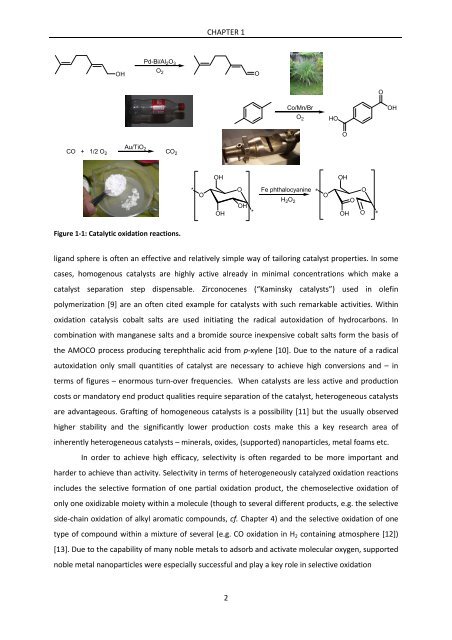Heterogeneously Catalyzed Oxidation Reactions Using ... - CHEC
Heterogeneously Catalyzed Oxidation Reactions Using ... - CHEC
Heterogeneously Catalyzed Oxidation Reactions Using ... - CHEC
Create successful ePaper yourself
Turn your PDF publications into a flip-book with our unique Google optimized e-Paper software.
CO + 1/2 O 2<br />
Figure 1‐1: Catalytic oxidation reactions.<br />
CHAPTER 1<br />
O<br />
OH 2<br />
O<br />
Au/TiO 2<br />
Pd-Bi/Al 2O 3<br />
CO 2<br />
*<br />
O<br />
ligand sphere is often an effective and relatively simple way of tailoring catalyst properties. In some<br />
cases, homogenous catalysts are highly active already in minimal concentrations which make a<br />
catalyst separation step dispensable. Zirconocenes (“Kaminsky catalysts”) used in olefin<br />
polymerization [9] are an often cited example for catalysts with such remarkable activities. Within<br />
oxidation catalysis cobalt salts are used initiating the radical autoxidation of hydrocarbons. In<br />
combination with manganese salts and a bromide source inexpensive cobalt salts form the basis of<br />
the AMOCO process producing terephthalic acid from p‐xylene [10]. Due to the nature of a radical<br />
autoxidation only small quantities of catalyst are necessary to achieve high conversions and – in<br />
terms of figures – enormous turn‐over frequencies. When catalysts are less active and production<br />
costs or mandatory end product qualities require separation of the catalyst, heterogeneous catalysts<br />
are advantageous. Grafting of homogeneous catalysts is a possibility [11] but the usually observed<br />
higher stability and the significantly lower production costs make this a key research area of<br />
inherently heterogeneous catalysts – minerals, oxides, (supported) nanoparticles, metal foams etc.<br />
In order to achieve high efficacy, selectivity is often regarded to be more important and<br />
harder to achieve than activity. Selectivity in terms of heterogeneously catalyzed oxidation reactions<br />
includes the selective formation of one partial oxidation product, the chemoselective oxidation of<br />
only one oxidizable moiety within a molecule (though to several different products, e.g. the selective<br />
side‐chain oxidation of alkyl aromatic compounds, cf. Chapter 4) and the selective oxidation of one<br />
type of compound within a mixture of several (e.g. CO oxidation in H2 containing atmosphere [12])<br />
[13]. Due to the capability of many noble metals to adsorb and activate molecular oxygen, supported<br />
noble metal nanoparticles were especially successful and play a key role in selective oxidation<br />
OH<br />
OH<br />
2<br />
O<br />
OH<br />
*<br />
Co/Mn/Br<br />
O 2<br />
Fe phthalocyanine ∗<br />
H 2O 2<br />
O<br />
HO<br />
O<br />
OH<br />
OH<br />
O<br />
O<br />
O<br />
∗<br />
O<br />
OH



